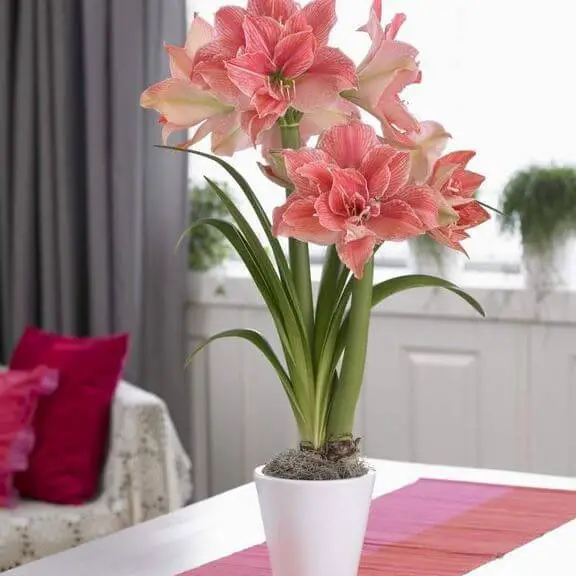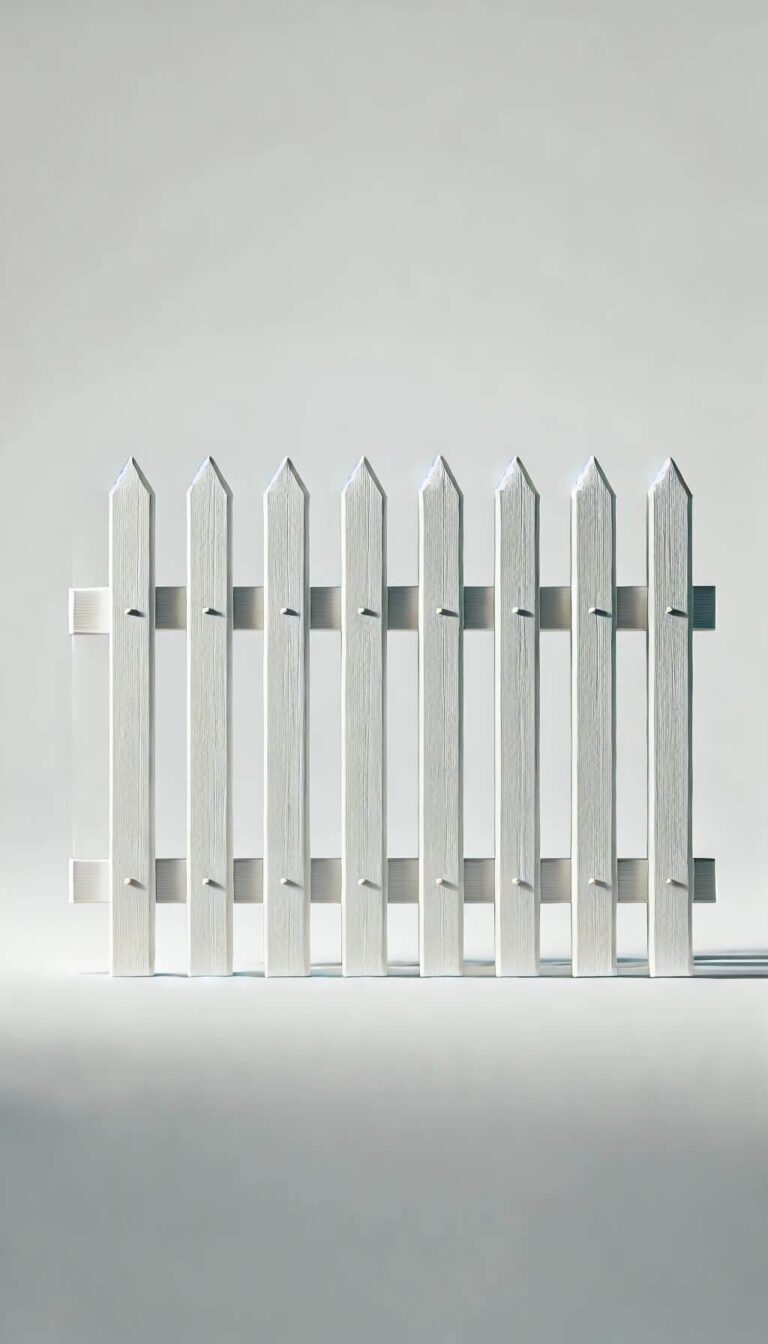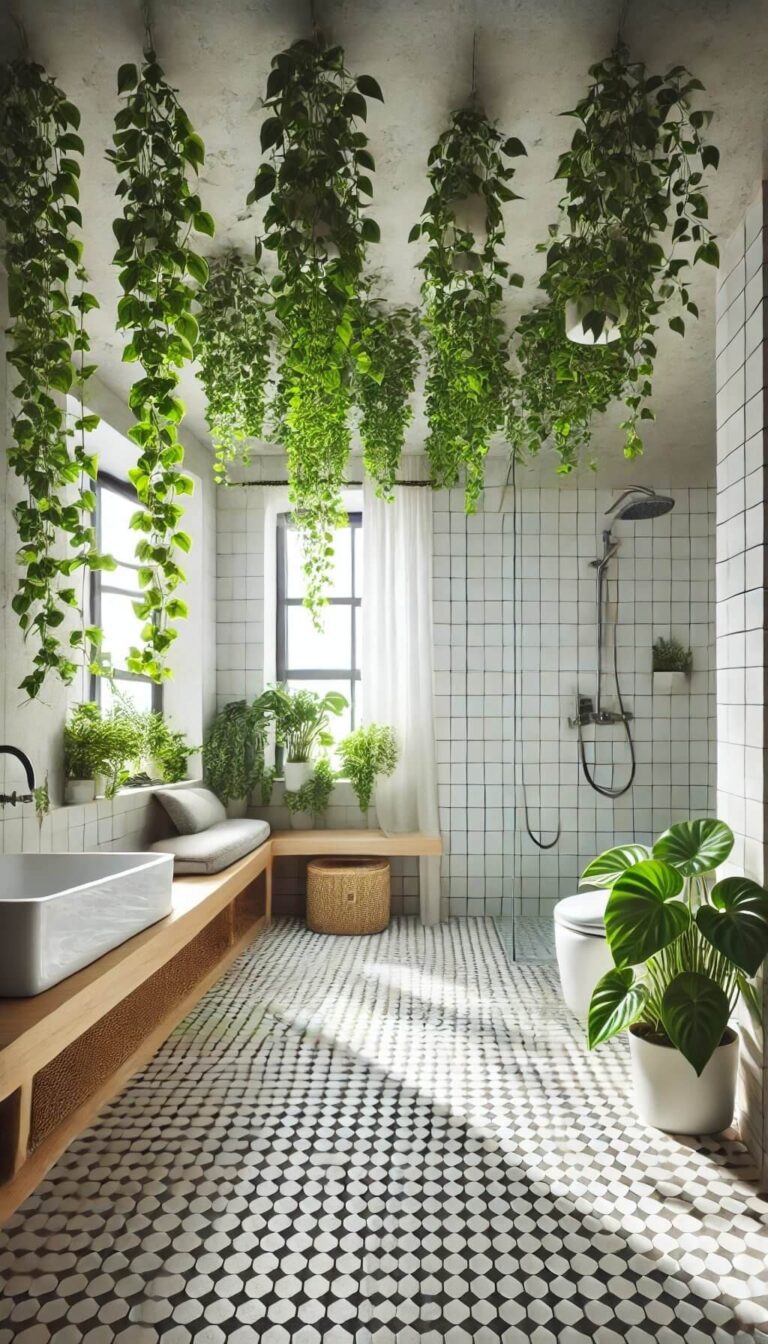26+ Different Types Of Bathtubs: Materials & Brands (Pros And Cons)
The allure of a relaxing soak in the tub, accompanied by a glass of wine or a great book, is a universal experience that evokes feelings of serenity and calmness. It’s no wonder then that homeowners often prioritize installing a bathtub in their bathrooms when given the opportunity. However, with so many options available, choosing the right type of bathtub can be overwhelming.
In this article, we’ll delve into the most common types of bathtubs, including their materials, and provide an honest assessment of their pros and cons to help you make an informed decision.
Types of bathtubs
Let’s start by exploring the various types of bathtubs that exist. We’ll delve into the specific bathroom settings where each type thrives, as well as their respective advantages and disadvantages.
Alcove tub
The Amazon-bought three-wall-alcove bathtub has become a staple in many modern homes. Its design features a showerhead and fits snugly into a three-sided enclosure, typically made of glass. The combination of form and function makes it a popular choice among homeowners. On the plus side, this tub is functional, relatively affordable, and offers low-maintenance upkeep. Additionally, its versatility in terms of aesthetic appeal means it can complement various bathroom designs.
However, it does require careful installation to ensure a proper fit with the surrounding walls, which may be a drawback for some. Furthermore, the lack of an apron on all four sides can make it less suitable for larger bathrooms or those with unique layouts. Overall, this bathtub is well-suited for smaller spaces and can provide a great bathing experience.
Claw-foot tub
Amazon shoppers can’t resist the allure of this freestanding tub, boasting a timeless design that effortlessly blends form and function. Its distinctive claw-feet evoke the opulence of Renaissance-era aesthetics, while its curved silhouette and defined walls create a sense of grandeur in any bathroom.
The tub’s vintage charm is undeniable, making it a stylish addition to even the most modern of bathrooms.
However, its unique shape means that options are limited when it comes to choosing from various designs. Nevertheless, the visual impact is undeniable – this tub makes a statement.
While the high-end price tag may be a deterrent for some, the tub’s ease of installation and generous size make it an attractive option for those seeking a deep-soaking experience.
If only there was a compromise to be had with the lack of storage space for toiletries – but perhaps that’s a small price to pay for such a majestic addition to one’s bathroom.
Combination tubs
Experience the ultimate in bathroom luxury with combination tubs from Amazon. These innovative products combine multiple features into one sleek design, offering a comprehensive bathing experience that includes relaxation, deep soaking, and hydrotherapy options. With built-in shower heads, whirlpool jets, and air jets, you can indulge in a spa-like retreat right in your own home.
While the initial investment may be higher due to the multitude of features, the long-term benefits far outweigh the cost. Additionally, combination tubs are designed to maximize space, making them suitable for both small and large floor plans. However, their unique design does present some maintenance challenges, requiring a bit more effort to keep clean and in top condition.
Corner tub
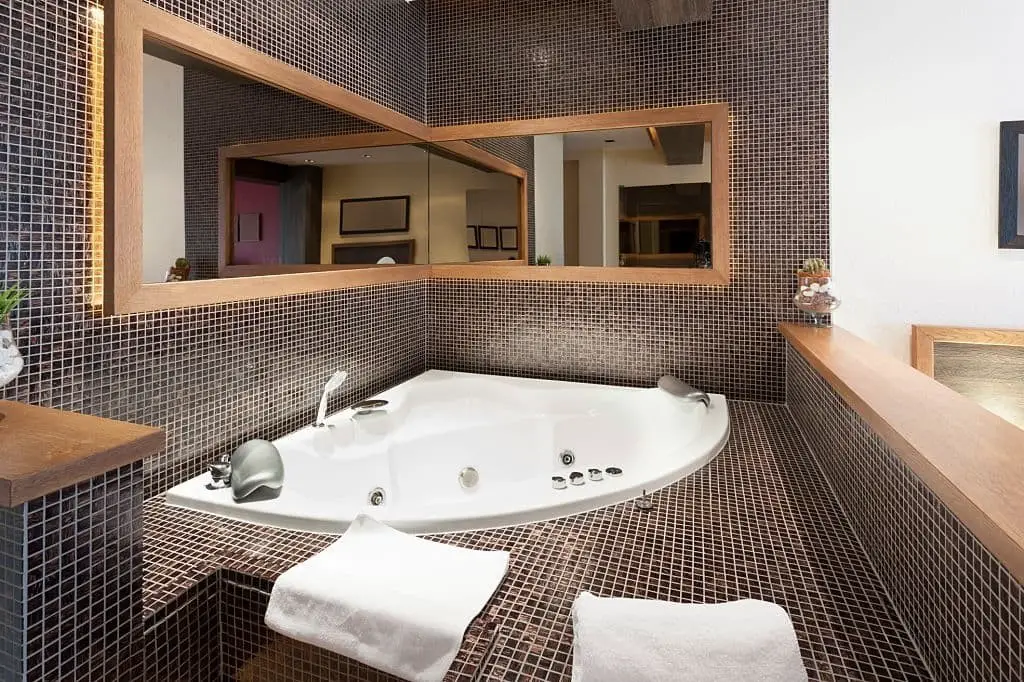
The asymmetrical shape of this tub makes it an ideal fit for smaller bathroom corners. Available in both triangular and rectangular designs, these compact tubs are perfect for maximizing space in tight spaces.
If you’re looking to optimize functionality in a small bathroom, this tub is definitely worth considering. Its unique design allows for elevation on a platform and can be enclosed with only two-sided enclosures, unlike traditional alcove bathtubs.
The pros of this design include premium space maximization, versatility, and the ability to position it in just one corner. On the other hand, limited accessibility may be a drawback. Additionally, this tub can be enclosed using drop-in, glass walls or elevated decks, providing flexibility in terms of installation options.
Drop-in tubs
Amazon shoppers can also find drop-in bathtubs that offer a luxurious spa experience without breaking the bank. These tubs feature a finished interior and are enclosed by a pre-fabricated deck, which provides ample space for toiletries like shampoo and soap. The design requires a larger floor area, but it can be easily integrated into an alcove format. One of the main advantages is the deep soaking feature, perfect for unwinding after a long day.
However, the high-end bearings and lack of slip-grip handles might make it tricky to get in and out of the tub, especially for those with mobility issues. Additionally, installation can be challenging without professional help, which may add to the overall cost. On the downside, drop-in bathtubs are generally more expensive than alcove models.
Freestanding tubs
Freestanding tubs, like those found on Amazon, are a popular choice among homeowners looking to add a touch of luxury to their bathrooms. These classic clawfoot tubs stand tall from the floor, providing a unique visual experience that can be enjoyed in larger bathrooms or cleverly incorporated into three-sided alcoves. While they may be more expensive than traditional drop-in tubs, freestanding models offer a high-end look and feel that’s perfect for retro and contemporary designs.
However, it’s important to consider the pros and cons before making a purchase.
On the plus side, freestanding tubs can add significant visual impact to a room and even increase the home’s resale value. They also offer the flexibility to be positioned anywhere in the bathroom, allowing homeowners to get creative with their design.
On the downside, these tubs often require additional accessories like stools or caddies, which can add to their overall cost.
Additionally, they may not be the most practical choice for homes with children or elderly occupants due to their heavy construction and exposed plumbing. With proper maintenance, however, a freestanding tub can provide years of enjoyment.
Hot tub
Hot tubs have earned a reputation as the epitome of relaxation and rejuvenation. Their versatility is one of their greatest strengths, as they can be installed both indoors and outdoors, and come in a wide range of finishes, constructions, shapes, and sizes. Designed for warm immersion, hot tubs often feature built-in water jets, some even incorporating massagers and other therapeutic features to promote deep relaxation and healing.
While they may be expensive, the benefits they offer are undeniable, including the ability to create a resort or spa-like atmosphere in the comfort of your own home. For those seeking hydrotherapy, hot tubs provide an unparalleled level of relief from muscle tension and stress. Their adaptability and range of functions only add to their appeal.
Japanese style tub
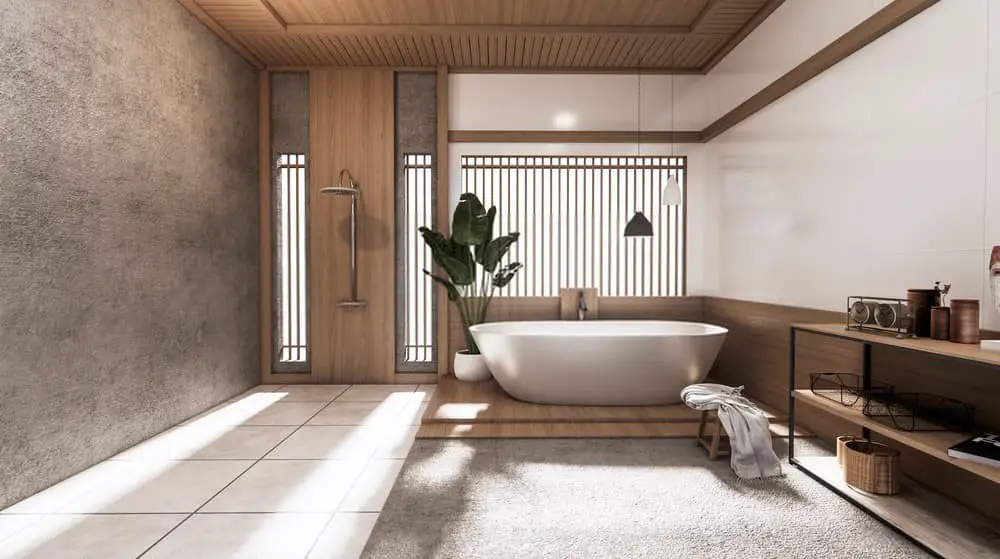
The Japanese Ofuro, also known as a soaking tub, is designed with spa-like relaxation in mind. Its freestanding form, sloped walls, and generous depth create a serene atmosphere that invites deep contemplation and rejuvenation. Unlike traditional tubs, the Ofuro does not come equipped with a built-in shower head, instead, it’s meant to be used after showering from a separate area. This unique design allows for an immersive soaking experience that washes away the stresses of the day.
The Ofuro offers several benefits, including its visually stunning appearance, which can add significant value to a home. However, it’s also important to note that this type of tub is often expensive and requires more maintenance than other options. Furthermore, the sloped walls are more accessible than those found on traditional freestanding tubs, making it an attractive option for individuals with mobility concerns.
While there is no built-in storage for toiletries, the Ofuro’s focus on relaxation means that users are unlikely to need easy access to their products during use.
Jetted tubs
For those seeking a spa-like experience at home, jetted tubs are an excellent option. These tubs can be designed as alcove or drop-in models, featuring air jets that provide the ultimate in relaxation and hydrotherapy. Perfect for individuals struggling with back pain, arthritis, or joint soreness, the adjustable air jets ensure a customized soothing experience. The benefits of these tubs include their versatility, coming in various forms, finishes, and features.
However, it’s essential to consider the potential drawbacks, including higher maintenance and installation costs. Nevertheless, the therapeutic benefits of jetted tubs make them an ideal choice for those seeking deep relaxation and relief from physical discomfort.
Pedestal tubs
Amazon offers a unique take on the classic freestanding tub with its pedestal-mounted design, which elevates the traditional clawfoot tub to a modern retro aesthetic in the bathroom. This subtype of freestanding tub boasts a range of forms, builds, and finishes, catering to diverse tastes and preferences. While it provides a high-end look and feel, the pedestal design also raises concerns about maintenance, as it may require more upkeep compared to other types of tubs.
Furthermore, this style is often pricier than others on the market, making it an investment for those seeking a luxurious bathing experience. Despite these drawbacks, the pedestal-mounted freestanding tub excels at creating a deep soaking ambiance, perfect for relaxing and rejuvenating in the tub.
Undermount tub
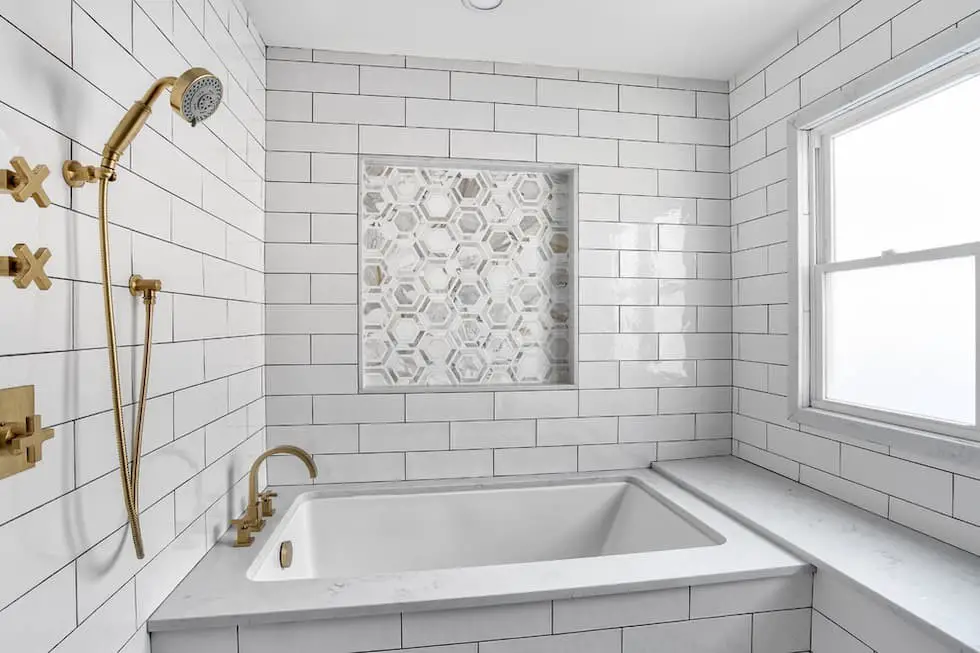
Undermount tubs share similarities with drop-in tubs, differing mainly in their covered rim as opposed to the exposed rim of their counterparts. The most common materials employed for this rim are tile and stone. Notably, undermount tubs often sit atop a raised platform or built-in deck. In terms of pros and cons, undermount tubs offer an upscale, luxurious ambiance, albeit at a higher cost when it comes to repairs or removal.
Additionally, they provide ease of cleaning and low-maintenance, though the installation process can be relatively expensive. Furthermore, these tubs are designed with durability in mind, built to withstand the test of time.
Walk-in tubs
The Amazon shop features a specially designed soaking tub that caters to individuals with mobility concerns. Its unique design includes a high chair and grab bars, ensuring greater stability and comfort while getting in and out of the tub. The side door opens at a convenient one-step entry, making it an ideal solution for those with limited mobility.
In terms of functionality, these tubs offer numerous air jets that provide therapeutic and pain-relieving benefits.
They are typically installed in an alcove-style format, occupying the space of traditional bathtubs on the floor. This setup allows users to fully immerse themselves in a relaxing experience, perfect for individuals seeking relief from discomfort or chronic pain.
Some key advantages of these tubs include their upscale appearance, which can elevate the overall aesthetic of any bathroom.
However, it’s essential to note that they come with a higher price tag and require more maintenance compared to traditional tubs.
Whirlpool and air tubs
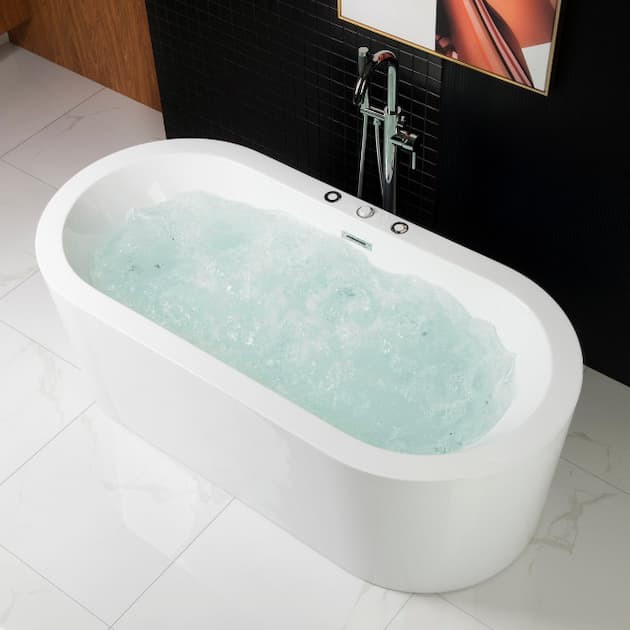
Whirlpools and air tubs share a familial connection, often packaged together as part of a comprehensive bathing experience. A step beyond traditional jetted tubs, these hybrid vessels combine the soothing effects of water jets with the invigorating power of air jets, strategically positioned to deliver targeted therapeutic benefits. This unique tub design also lends itself well to concentrated exercise routines, capitalizing on the rejuvenating properties of the whirlpool’s water jets.
The pros and cons of such a setup are multifaceted. On one hand, it offers an impressive range of forms, finishes, shapes, and sizes to suit any decor or preference. On the other hand, these premium fixtures often come with a hefty price tag. Furthermore, they can be installed in both indoor and outdoor settings, providing flexibility for homeowners. However, their high-maintenance requirements may not appeal to all users seeking a low-fuss bathing experience.
For those prioritizing therapeutic benefits, however, the rewards may well outweigh the extra effort required.
Bathtub materials
With our exploration of tub types under our belt, let’s dive deeper into the various materials used to create the distinctive appearance and aesthetic appeal of bathtubs. From sleek acrylic surfaces to robust steel constructions, each material contributes its unique characteristics to shape the overall look and feel of a bathtub.
Acrylic
When it comes to shopping for a bathtub on Amazon, acrylic is often a popular choice due to its similarities with fiberglass. Both materials share a similar aesthetic and possess many comparable characteristics. In fact, some acrylic tubs are even reinforced with fiberglass sheets for added strength. One of the primary advantages of acrylic tubs is their affordability and lightweight nature, making them an attractive option for those looking to upgrade their bathroom without breaking the bank.
Additionally, acrylic materials offer a wider range of colors and finishes compared to other options, allowing homeowners to choose a style that perfectly suits their unique taste. However, it’s essential to note that acrylic tubs are not invincible and can be prone to cracking, breaking, or fading over time. Furthermore, while they are generally low maintenance, their durability is somewhat lacking in comparison to other materials.
On the plus side, acrylic tubs do offer a higher-end look that can elevate the overall ambiance of a bathroom, making them a viable option for those seeking a stylish and budget-friendly solution.
Cast iron
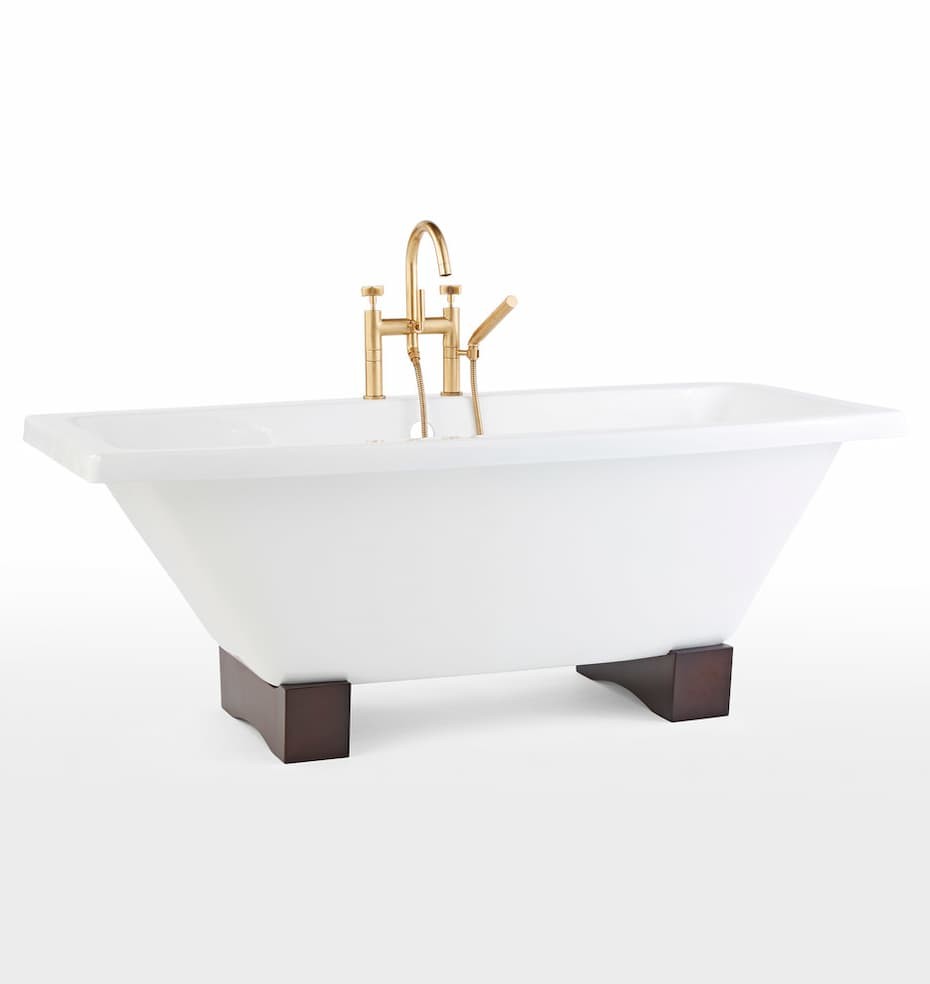
When it comes to finding a bathtub material that will truly stand the test of time, cast iron tubs are an excellent option to consider. This luxury material is crafted from molten iron and finished with a glossy enamel coating, giving bathtubs a sleek and sophisticated appearance. One of its most notable advantages is its ability to retain heat exceptionally well, making it a top choice for those seeking a cozy bathing experience.
While cast iron tubs offer several benefits, including their unmatched durability and resistance to dents, scratches, and chipping, they also come with some drawbacks. The material can be heavy and expensive, which may be a drawback for some homeowners. Additionally, the installation, repair, and replacement of cast iron tubs can be more challenging than other materials.
Despite these limitations, cast iron tubs do offer a range of benefits, including their ability to retain heat and come in different colors, shapes, and sizes.
Ceramic
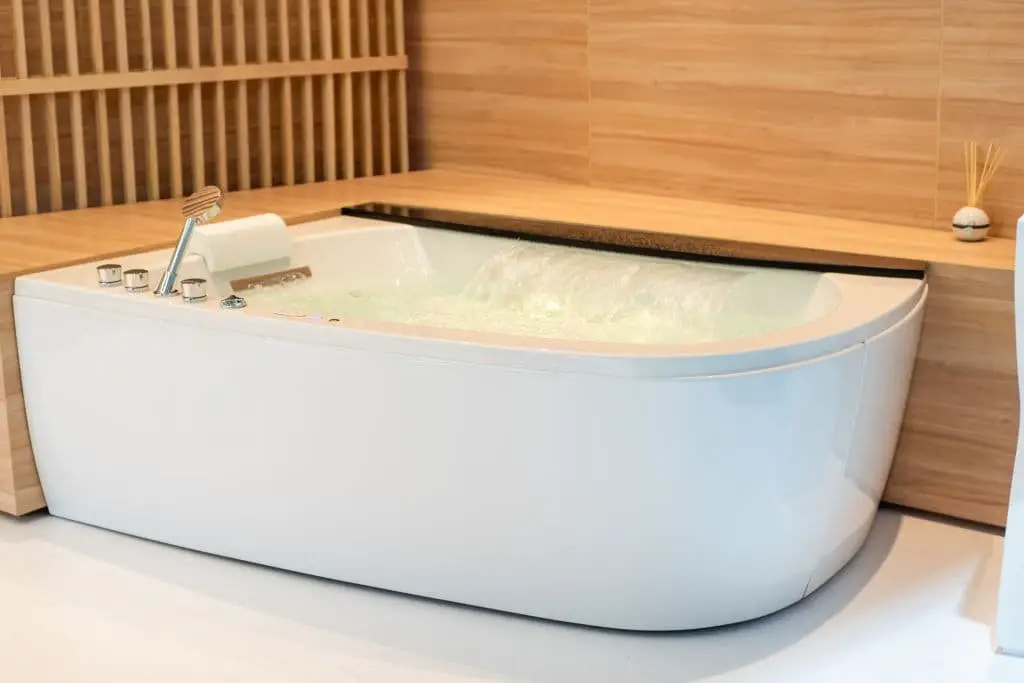
While ceramic tubs share some similarities with cultured marble, they also have their own unique characteristics. One of their biggest advantages is the wide range of design options available, making it easy to find a style that fits your bathroom’s aesthetic. Additionally, ceramic tubs are generally inexpensive and low-maintenance, requiring only occasional cleaning to keep them looking their best.
However, it’s worth noting that the irregular surface may provide a slightly different sensory experience compared to other materials. On the plus side, this texture can also add visual interest to the space. In terms of pros and cons, ceramic tubs offer a lot of benefits, including wide design options and low maintenance requirements. However, some users may find the frequent cleaning required for ceramic tile-lined tubs to be a drawback.
Cultured marble
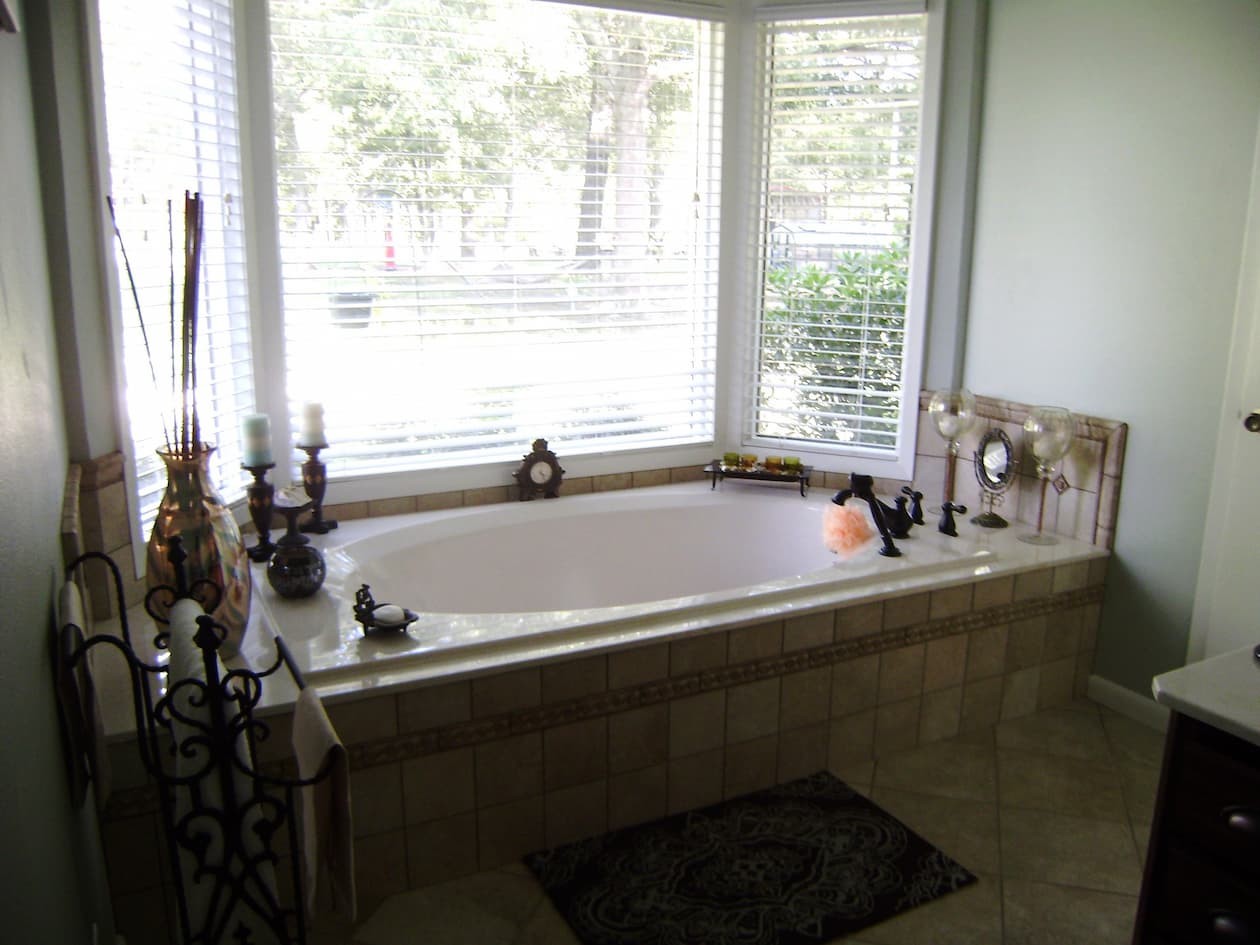
This premium bathtub material boasts an impressive range of options, including varying sizes, styles, and colors. Its unique composition is made from crushed limestone mixed with resin, which is then polished to a high-gloss finish using Gelcoat. While it may come at a higher price point compared to other materials, its durability and versatility make it a worthwhile investment.
Key advantages include the availability of diverse color, size, shape, and style choices, as well as its superior performance compared to fiberglass and acrylic. However, one potential drawback is that this material may be less widely available in the market.
Fiberglass
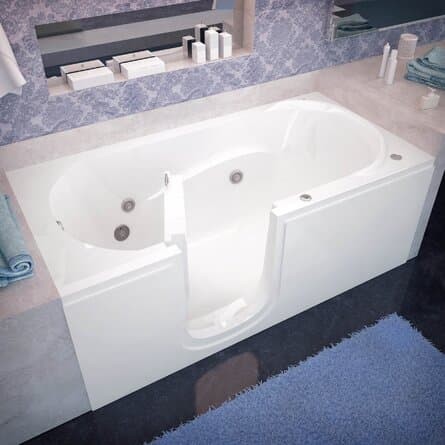
Wayfair’s offering is often considered the most affordable bathtub material option. Known as fiberglass reinforced plastic, it’s a composite made from fiberglass shards coated with resin. This type of bathtub excels in alcove and corner installations. While it has its advantages, there are also some drawbacks to consider.
Porcelain on steel
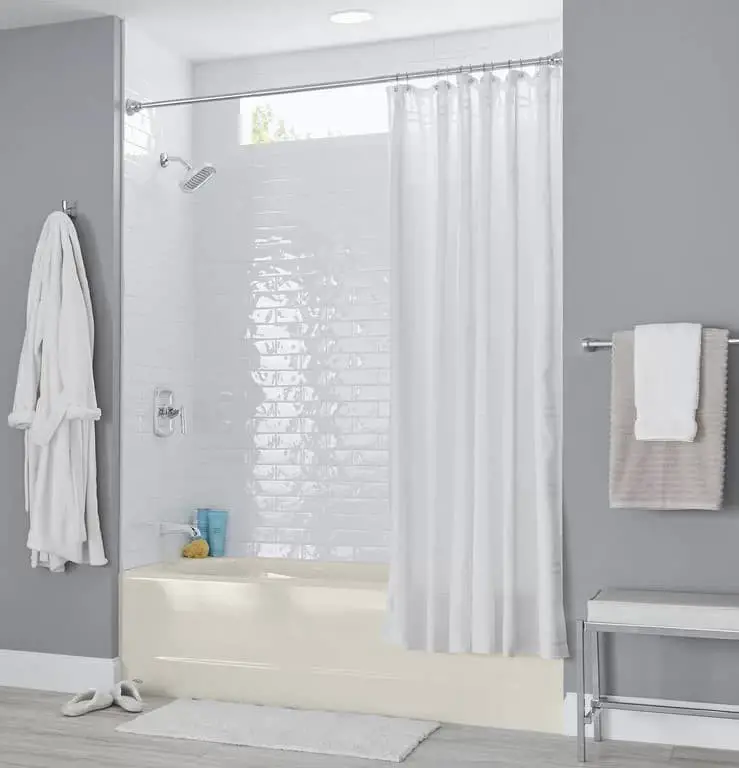
The enameled steel bathtub is another widely used option due to its sleek appearance and affordable price point. This material is created by stamping a sheet of steel and reinforcing it with porcelain enamel, earning it the name ‘enameled steel.’ With proper care, you can expect this finish to remain glossy for a prolonged period.
The benefits of enameled steel bathtubs include their exceptional durability, substantial weight compared to fiberglass and acrylic materials, and low maintenance requirements. However, they may be prone to rusting or chipping on the surface, and their glossy finish might not be as versatile in terms of shape and size options. If you’re looking for an alternative to acrylic or fiberglass bathtubs, enameled steel is a viable choice.
Stone resin
When considering a statement piece for your bathroom, natural stone resin tubs stand out for their durability and luxurious aesthetic. While they may require some extra effort to install due to the unique challenges of working with heavy materials like sandstone, basalt, travertine, marble, onyx, and granite, the end result is well worth the investment.
The benefits of these tubs include a customizable design that can be tailored to your personal style, as well as the added bonus of being sturdy and built to last. However, it’s also important to consider the potential drawbacks, including the need for additional support such as a plinth or platform, as well as the fact that they can be heavy and high-maintenance. For those looking to make a statement in their bathroom, these tubs may be worth the extra expense.
Wood
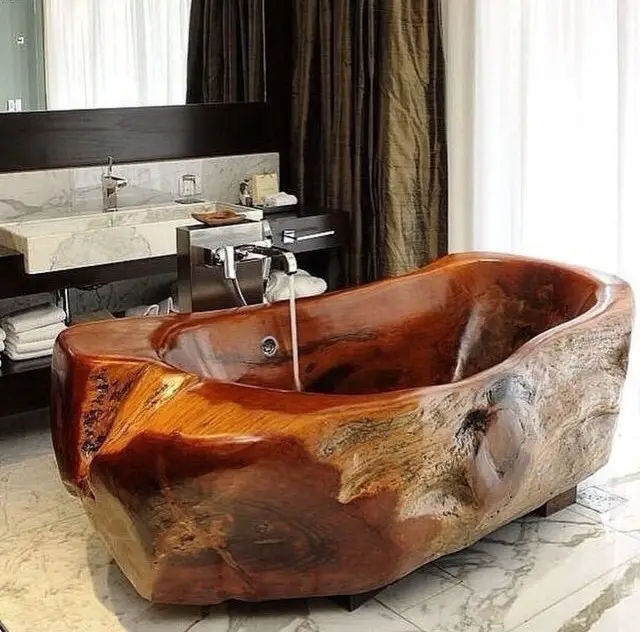
The deep soaking tub’s design makes it a stunning focal point in the bathroom, with its timeless appeal and customizability allowing for a unique look that complements the space. When it comes to selecting the right wood for this type of tub, high-quality options like walnut, ash wood, teak, maple, and cherry offer a natural beauty that’s hard to match.
While these woods provide pros such as a durable and attractive appearance, they also come with cons like being expensive and high-maintenance, particularly when it comes to molding issues.
Solid surface
This relatively new entrant in the bathtub market boasts impressive durability, offering a range of colors and styles to suit diverse tastes. Its construction combines synthetic materials with polymers, resulting in a robust and long-lasting product. While it excels in several areas, some notable advantages include: high design variation, durable finish that can be easily repaired, and natural appearance.
On the flip side, this material presents some drawbacks, such as its heavy weight making installation more challenging and relatively high cost compared to other options available. Furthermore, its accessibility is limited in the market, although its ability to retain heat makes it an attractive choice for those seeking a comfortable bathing experience.
Stainless steel
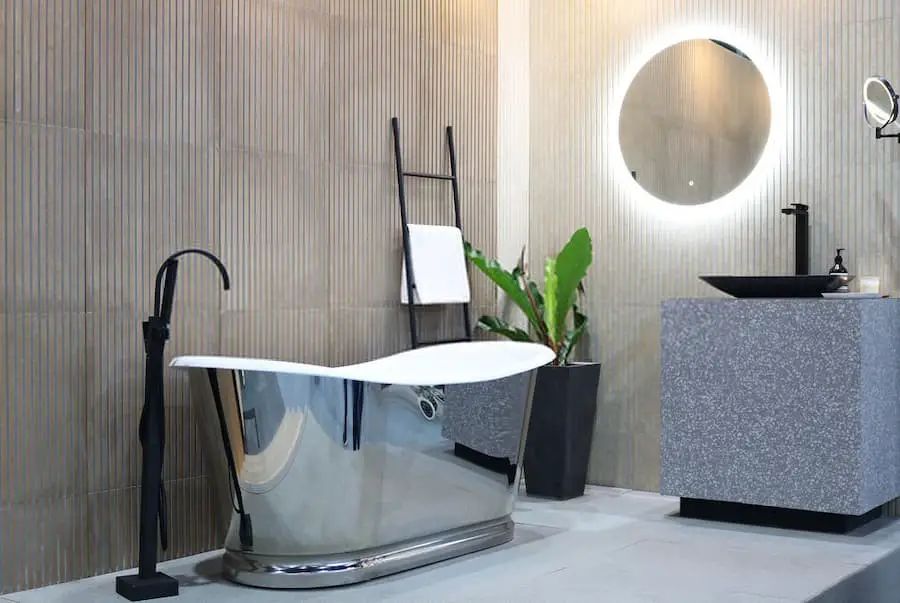
Stainless steel bathtubs are a popular choice for their modern, industrial aesthetic. However, this durability comes at a cost – they’re considered a premium product and can be pricey. While less expensive than some stone materials, stainless steel tubs still require a significant investment.
On the plus side, these tubs boast a sleek, polished look that can elevate the overall design of a bathroom.
They’re also relatively lightweight and easy to install, making them a practical choice for many homeowners.
That being said, stainless steel bathtubs may not provide the most stable feeling, which could be a drawback for some users. Additionally, they may require additional support in the form of fasteners to prevent shifting or movement over time.
On the bright side, these tubs are low-maintenance and retain heat exceptionally well, making them a great choice for those who value durability.
Overall, stainless steel bathtubs offer a unique combination of style, functionality, and longevity that’s hard to match with other materials.
Bathtub brands
While there are numerous options for bathtubs on the market, some brands truly excel in terms of the variety of types and styles they offer. For those looking to make an informed decision, it’s worth exploring the most popular and well-regarded bathtub brands. By doing so, you’ll gain a comprehensive understanding of what’s currently trending and highly praised in the world of bathtubs.
American Standard

American consumers are no strangers to the reliability of this 140-year-old household brand when it comes to bathroom and kitchen fixtures. Its extensive portfolio spans a wide range of bathtub styles, catering to diverse tastes and needs. From kid-friendly designs to pet-friendly soak tubs and sleek, modern models that seamlessly integrate into any bathroom setting. Beyond its product offerings, the company takes pride in providing flexible installment payment options for customers.
Moreover, its products are not only ADA- and WaterSense-certified but also backed by a comprehensive warranty that includes installation and labor costs. Notably, this manufacturer is known for its commitment to customer satisfaction, reflected in its consistently high ratings from online reviews. Additionally, it offers free online estimates for bathtub needs, although FAQs are not currently available online.
For those seeking to purchase products from this trusted brand, Amazon is a popular platform.
Anzzi

Since its inception in 2005, the company has gained a reputation for crafting artisanal products that seamlessly blend design, ergonomics, and functionality. Their product range is incredibly diverse, encompassing not just traditional bathtub styles but also innovative offerings like medical-grade walk-in bathtubs and drop-in whirlpool tubs. Moreover, they manufacture a wide variety of materials for tubs, from high-quality acrylic to natural stones, catering to different tastes and preferences.
One of the company’s notable strengths lies in its commendable build and safety features, backed by a limited lifetime warranty. The design options are also highly varied, allowing customers to choose a tub that perfectly suits their style. However, some customers have expressed disappointment with the company’s customer service. On a positive note, the medical-grade tubs they offer receive high praise.
Lastly, the price points vary across different products, ensuring there’s something for every budget.
Delta

This renowned bath and plumbing manufacturer, headquartered in Indiana, has carved a niche for itself by pioneering water-saving innovations such as the MagnaTite, Touch2O, and H2O Kinetic. Their product portfolio is diverse, encompassing not only faucets but also acrylic, fiberglass, enameled steel, and cast-iron bathtubs, each designed to meet exacting standards of build, form, and function.
One of the significant advantages of this brand is its comprehensive 10-year warranty, which covers installation and labor costs. However, it’s worth noting that their products tend to be pricier than average. On a positive note, the manufacturer offers a wide range of bathtubs in various sizes, shapes, and styles, ensuring ample coverage for diverse tastes and preferences.
Jacuzzi
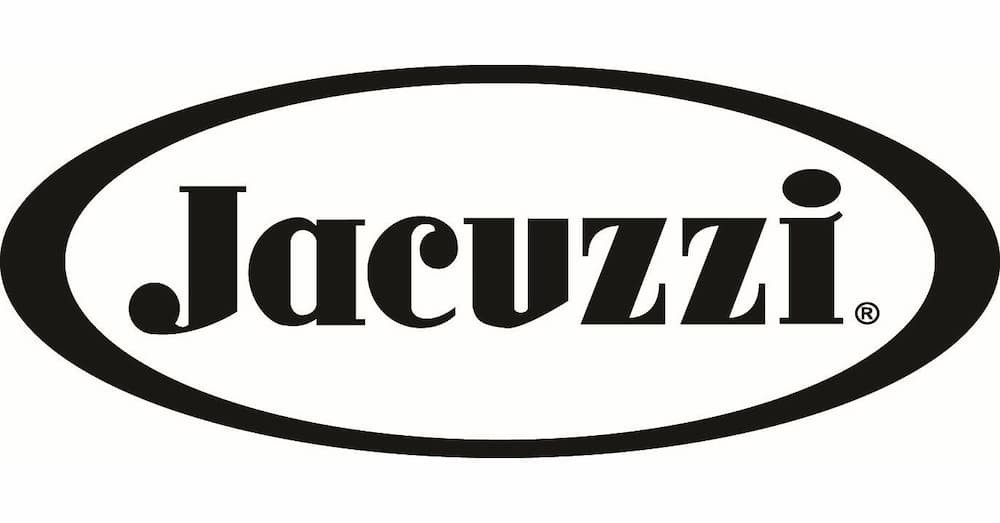
Jacuzzi is the brand credited with introducing whirlpool tubs to the world. They’ve earned a reputation for crafting cutting-edge bathtub designs that prioritize wellness and innovative features. Beyond their focus on functionality, they also offer a range of visually appealing tub styles that can seamlessly integrate into various bathroom décors.
On the plus side, Jacuzzi is known for its technological advancements and refined features like hydromassage, energy-saving capabilities, and specialized kits like Winter Pro Kit and Clear Ray technology. However, one potential drawback is the higher cost associated with their products.
Kaldewei

American Standard’s innovative spirit led the way in producing enameled stainless-steel tubs, while also introducing the world’s first seamless, freestanding bathtub. This pioneering effort transformed the corner tub landscape, setting new standards for design and functionality. Their sleek, linear bathtub styles boast ergonomic features, further solidifying their reputation for excellence.
The benefits of this brand’s products include a comprehensive 10-year warranty that covers both installation and labor costs. While the price points may be higher than some consumers’ budgets, the build quality, form, and function all meet exceptionally high standards. Furthermore, the tubs come in a range of sizes, shapes, and styles, each offering ample coverage and versatility.
Kingston Brass

Amazon’s California-based brand has been a popular choice for kitchen, bath, and plumbing products since its inception in 1998. While they may not be the most expensive option on the market, their range of affordable products makes them an attractive choice for many consumers. When it comes to bathtubs specifically, Amazon’s brand offers a diverse selection of alcove, freestanding, and pedestal tubs made from cast iron, solid surface, and acrylic materials.
One of the standout pros of this brand is its competitive pricing, which is hard to beat. However, buyers should be aware that their warranty coverage is limited, which may be a drawback for some. Nevertheless, Amazon’s brand is a great option for those looking for modern and contemporary bathtub designs at an affordable price point.
Kohler

Amazon’s American heritage dates back to 1873, with a reputation for crafting long-lasting kitchen and bathroom essentials. Their tub offerings are particularly notable, featuring cast iron bathtubs, walk-in, and drop-in models. What sets them apart is their seamless integration of technology and functionality.
The brand’s smart plumbing connection, voice recognition control, and water-saving technology are just a few features that make their products stand out.
For instance, the latter can help conserve up to gallons of water per month.
On the plus side, Amazon’s brand reputation is solid, backed by good customer service ratings and commendable warranty coverage. However, it’s worth noting that their products tend to come with higher price points. Additionally, while they may be best known for their tubs, they also offer a range of bathroom fixtures beyond just these.
Overall, Amazon’s commitment to quality and innovation has earned them a strong reputation in the market.
Toto

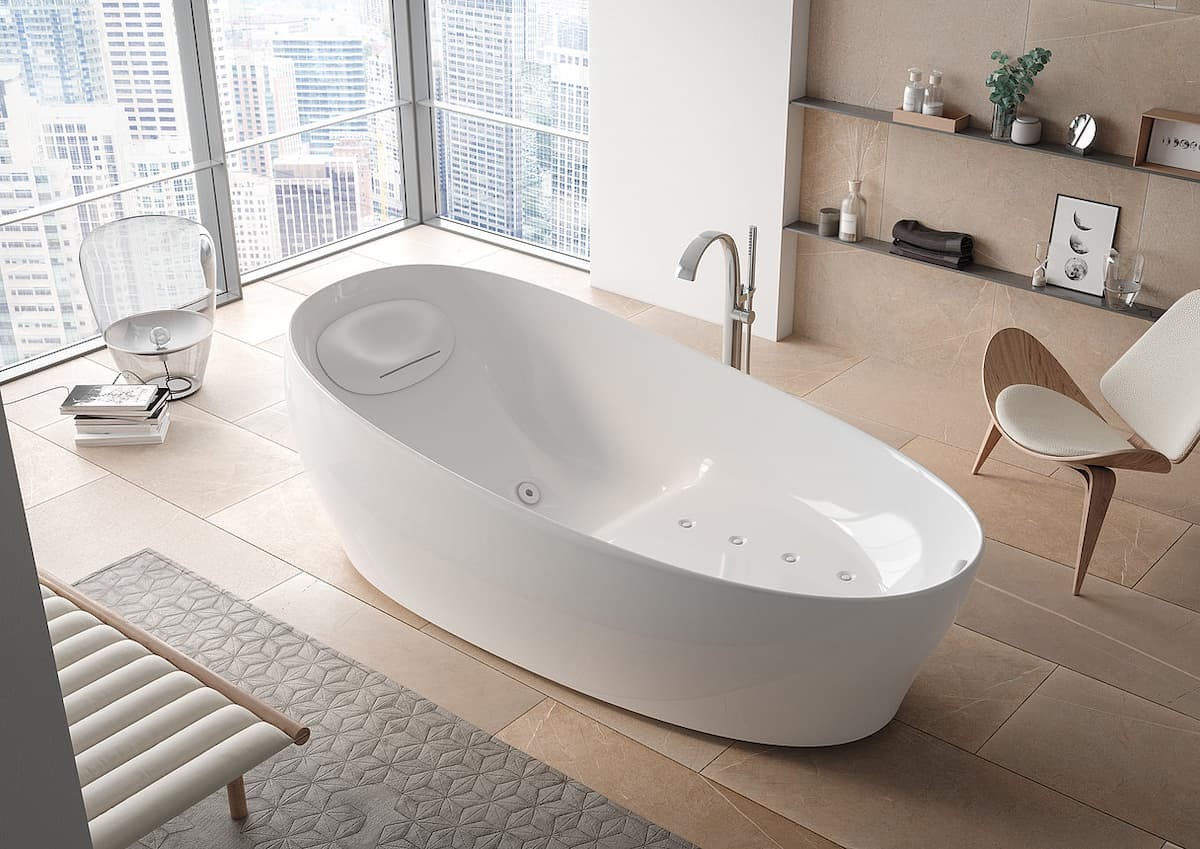
Founded in 1917, this Japanese brand has earned its reputation as the world’s largest toilet manufacturer, with their self-cleaning toilets being a particular standout. Beyond porcelain thrones, they also boast an impressive range of bathtubs, including top-rated drop-in tubs and enamel cast iron designs. Their offerings extend to slip-resistant models, remote-controlled jetted tubs, and even sleek cast-acrylic options.
This brand’s strengths lie in its durable and innovative product designs, which have garnered a wealth of accolades. While some bathtub selections may not be available, the brand’s commitment to sustainability has earned it notable certifications like WaterSense, ADA, and CalGreen. Additionally, their reasonable price points make them an attractive option for many consumers.
Universal Tubs
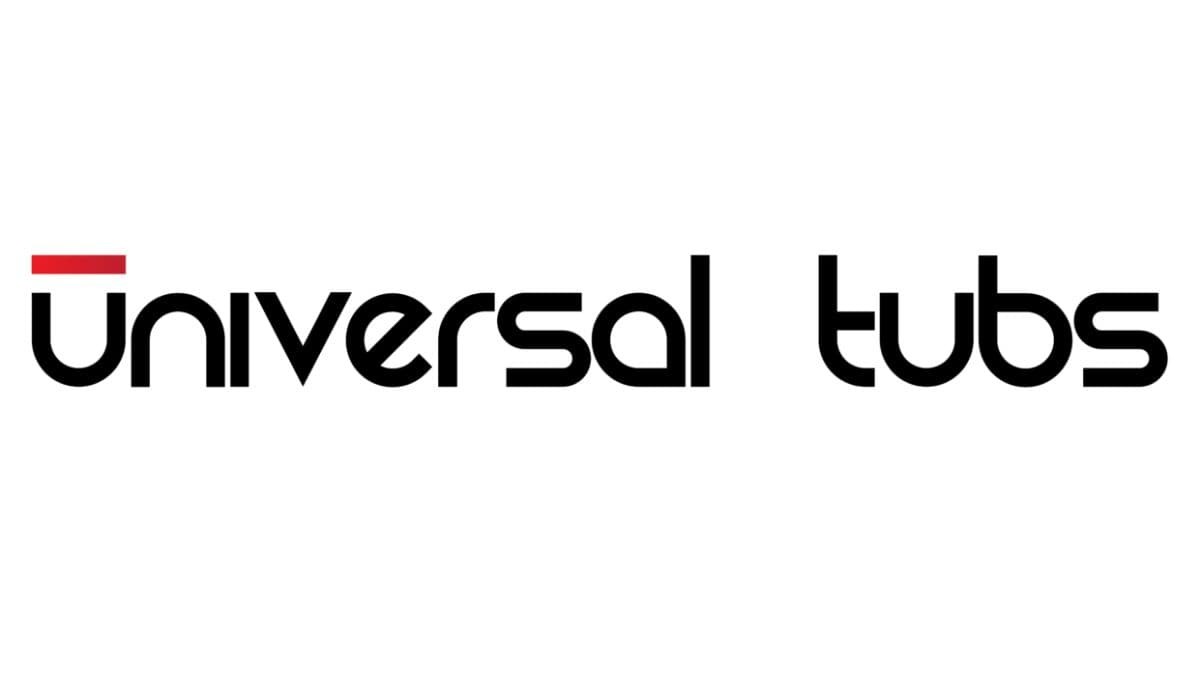
When it comes to walk-in tubs, Universal Tubs stands out for its commitment to safety and accessibility. Their products feature non-slip steps, good floor traction, and wide doors that make it easy to get in and out of the tub. Additionally, they offer a range of safety accessories such as contoured and heated seating, grab rails, and more. The company also uses a variety of materials including fiberglass, acrylic, solid surface, and cast-iron to create its walk-in tubs.
What’s more, their tubs are designed with hydrotherapy and wheelchair accessibility in mind, making them a great option for individuals who require extra support. Some benefits of Universal Tubs include contoured seats for all tubs, good customer service, and a wide range of styles, sizes, and shapes to choose from. However, it’s worth noting that some features may come at an additional cost, such as extended warranties on specific parts or heating accessories.
Overall, while the products may be on the higher side in terms of price, they offer a level of quality and accessibility that makes them a worthwhile investment for many individuals.
Factors to consider when buying a bathtub
When selecting a bathtub, there are several key factors to consider. Let’s focus on three crucial aspects: size, depth, and style. To ensure you find the perfect fit, keep these essential considerations in mind.
Size
When selecting a bathtub, it’s crucial to consider your specific needs and the available floor space in your bathroom. The most common sizes for standard bathtubs are 60 inches long by 30 or 32 inches wide. Soaking tubs, on the other hand, tend to be longer and narrower, typically measuring around 72 inches in length and 20-24 inches in width. To ensure a proper fit, it’s essential to take precise measurements of your bathroom floor space before finalizing your bathtub size selection.
Depth
When it comes to selecting the perfect bathtub, another crucial aspect to consider is its depth. This parameter directly impacts both the comfort level and soaking capacity of the tub. Typically, standard depths range from 14 to 24 inches. For those looking to conserve water, a shallower tub might be the way to go. Conversely, if you’re seeking a more immersive experience, opt for a deeper tub with a depth of at least 20 inches.
Style
When it comes to bathtubs, style refers to the material and type of tub you prefer. You have a wide range of options, including alcove, drop-in, freestanding, clawfoot, jetted, and more. While there isn’t inherently a ‘better’ bathtub style, the key is finding one that suits your needs and complements your bathroom’s interior design. To make an informed decision, it may be helpful to prioritize your preferences before exploring different bathtub styles.
Conclusion
While bathtubs may be a haven for relaxation, they’re more than just a place to unwind. Different materials are used in their construction, each offering distinct characteristics that cater to various purposes. When selecting the ideal bathtub, it’s essential to consider style, depth, material, and function to ensure a harmonious fit with your bathroom’s interior.
With this information, you’ll be well-equipped to create a concise list of options, eliminate unsuitable choices, and ultimately pick the perfect tub that meets your needs.
Related Posts
Walk-in tubs are a game-changer for elderly individuals, providing a sense of independence and comfort in their own homes. Four key features make them an attractive option for seniors: non-slip surfaces, comfortable seating options, safety grab bars, and easy-to-use controls. These thoughtful design elements combine to create a safe and enjoyable bathing experience.
On the other hand, becoming a kitchen and bath designer requires a passion for interior design, creativity, and attention to detail. The career pathway involves obtaining relevant education and training, building a portfolio of work, and staying up-to-date with industry trends and new products.
When it comes to bathroom design, traditional tiles are not the only option.
Alternative coverings such as glass, natural stone, or reclaimed wood can add visual interest and texture to this often-overlooked space. The key is finding a material that balances aesthetics with practicality.
In recent years, the focus has shifted from simply luxurious bathrooms to spaces that seamlessly blend luxury and functionality. Key trends include smart fixtures, rain showerheads, and ample storage solutions.
To extend the life of your bathroom, it’s essential to prioritize maintenance and repair tasks. By following four simple steps – inspecting for leaks, cleaning regularly, replacing worn-out parts, and addressing grout issues – you can ensure your bathroom remains a haven for years to come.
Finally, finding the right bath pillow can be overwhelming.
Considering factors such as comfort level, support style, and material quality will help you make an informed decision and enjoy a more relaxing bathing experience.

